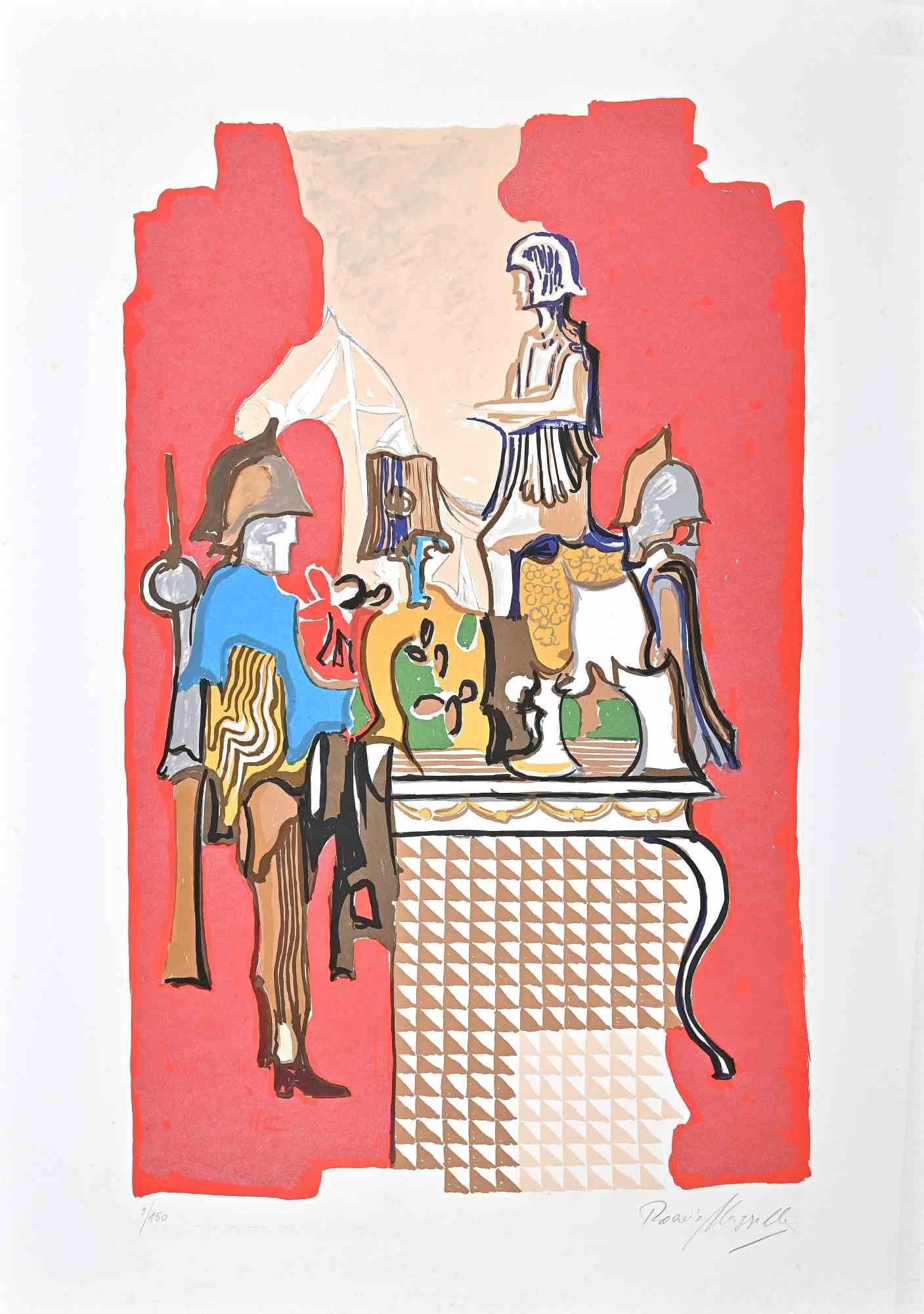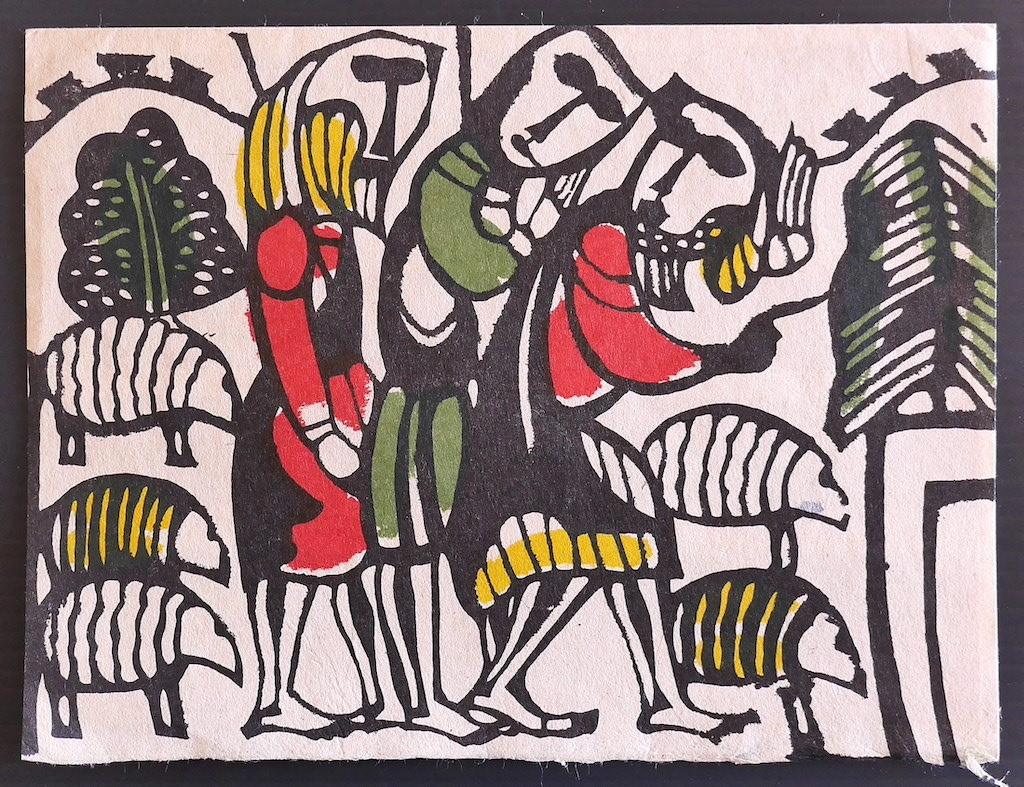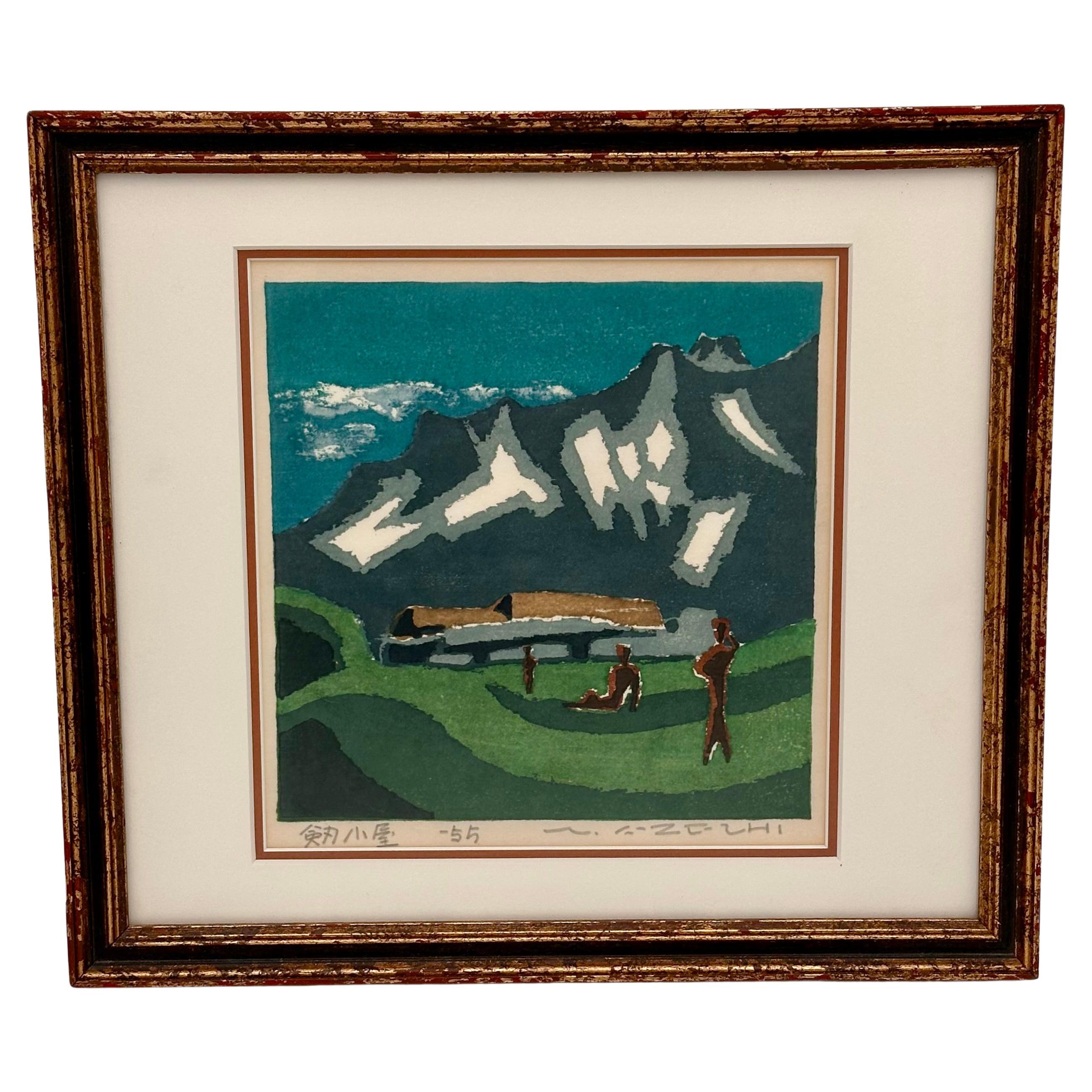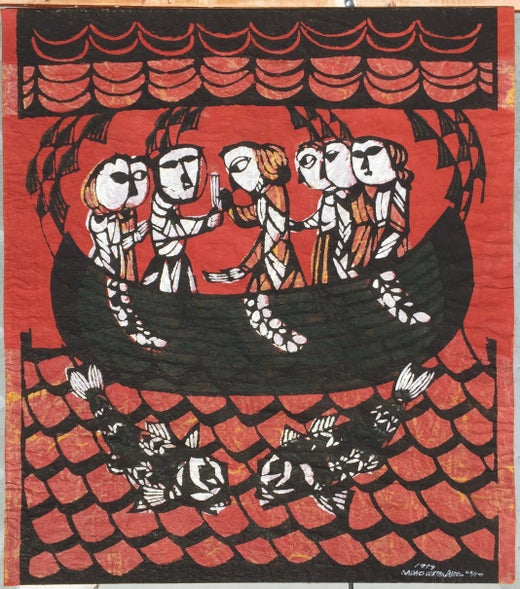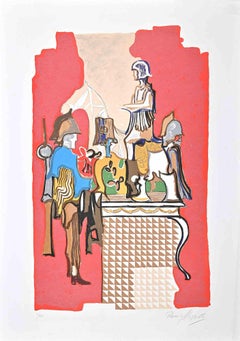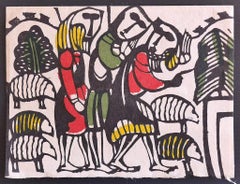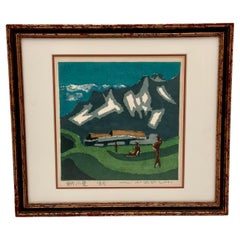Items Similar to Three Men Defending a Fort
Want more images or videos?
Request additional images or videos from the seller
1 of 10
Sadao WatanabeThree Men Defending a Fort1972
1972
$1,600
£1,232.45
€1,407.32
CA$2,282.43
A$2,496.56
CHF 1,310.13
MX$29,857.44
NOK 16,533.79
SEK 15,424.03
DKK 10,510.08
About the Item
This artwork, "Three Men Defending a Fort" 1972 is an original color stencil on hand crumpled momigami paper. It is hand signed, dated and numbered 5/20 in black ink by the artist. The artwork size is 26.5 x 22.5 inches, framed size is 36 x 31.75 inches. It is custom framed in a wooden gold frame, with fabric matting and black color spacer. It is in excellent condition.
About the artist:
Sadao Watanabe born and raised in Tokyo, was a Japanese printmaker in the 20th Century. He was famous for his Biblical prints rendered in the mingei (folk art) tradition of Japan. As a student of the master textile dye artist Serizawa Keisuke (1895-1984), Watanabe was associated with the mingei (folk art) movement.
His father died when Watanabe was ten years old. He dropped out of school at an early age and became an apprentice in a dyer's shop. A Christian woman in his neighborhood invited the fatherless boy to attend church with her. At the age of seventeen, Watanabe received baptism.
The young Watababe worked in dyers' shops, sketching patterns and dyeing clothes. In 1937, one year after Yanagi Soetsu (1889-1961), father of the Japanese mingei (folk art) movement, had established the Folk Art Museum, the 24-year-old Watanabe saw an exhibition of Serizawa Keisuke's (1895-1984) work. The event sowed the seeds of Watanabe's artistic endeavor. A few years later, Watanabe attended a study group in which Serizawa taught his katazome technique of stencilling and dyeing, which originated in Okinawa. From then on, the teacher-and-student relationship between Serizawa and Watanabe became strong and abiding.
The subject matter of Watanabe's prints is exclusively the gospel rendered in the mingei (folk art) approach. Influenced by Buddhist figure prints, Watanabe placed Biblical subjects in a Japanese context. In The Last Supper (1981) Watanabe depicts the disciples in kimono. On the table are bottles of sake and sushi.
Watanabe uses kozo paper (from mulberry tree) and momigami (kneaded paper). The momigami paper was crumpled by hand, squeezed and wrinkled to give a rough quality to the prints. The katazome method uses traditional organic and mineral pigments in a medium of soybean milk. The protein in the milk bound the colors to the paper's surface. The use of natural materials is one of the characteristics of mingei (folk art).
In 1958, Watanabe received first prize at the Modern Japanese Print Exhibition held in New York City for The Bronze Serpent showing Moses and the people of Israel. Watanabe's Kiku [Listening] (1960) was featured in the novelist James Michener's The Modern Japanese Print (1962), a book that introduced ten sosaku hanga artists to the Western audience.
The Vatican Museum, the British Museum, the Museum of Modern Art in New York, the National Museum of Modern Art in Tokyo and many other leading museums in the world had exhibited Watanabe's works. During President Lyndon Johnson's administration, Watanabe's prints were hung in the White House.
Watanabe once remarked that he preferred that his prints hang in the ordinary places of life: "I would most like to see them [his prints] hanging where people ordinarily gather, because Jesus brought the gospel for the people". Such is the mingei philosophy of art for the people and by the people.
References
• Pyle, Anne H. H. (April 2000), "A Christian Faith in the Tradition of Japanese Folk Art: The Art of Watanabe Sadao (1913-1996)", Arts Magazine: 20-29.
• Watanabe, Sadao; Takenaka, Masao (1986), Biblical Prints, Tokyo: Shinkyo Shuppansha.
• Watanabe, Sadao (2000), Printing the Word: the Art of Watanabe Sadao, New York: American Bible Society.
• Heeding the Voice of Heaven, Sadao Watanabe, Biblical Stencil Prints, Brauer Museum of Art, 2010, Valparaiso.
- Creator:Sadao Watanabe (1913 - 1998, Japanese)
- Creation Year:1972
- Dimensions:Height: 36 in (91.44 cm)Width: 31.75 in (80.65 cm)Depth: 1.35 in (3.43 cm)
- Medium:
- Movement & Style:
- Period:
- Condition:
- Gallery Location:San Francisco, CA
- Reference Number:Seller: wat/thr/men/011stDibs: LU66635765371
Sadao Watanabe
Sadao Watanabe, born in Tokyo in 1913, used the medium called kappazuri ("stencil printing"), a technique related to 'katazome' ("stencil dyeing"). 'Katazome' is said to have originated in Okinawa (the method there was called 'bingata'). The paper most widely used in Japan for stencil printing is called 'shibugami', made from several layers of 'kozo' paper laminated with persimmon tannin. The sheets are dried and smoke-cured to strengthen them and make them flexible and waterproof. Once the artist makes a drawing, it is fixed to the 'shibugami' with a thin adhesive. The basic pattern is then carved into a "key impression" stencil (the equivalent to the keyblock in woodblock printing) called the 'omogata'. If colors will also be used for the final design, separate stencils are sometimes cut for each color. If the stencil pattern has thin lines they can be reinforced with silk gauze, which still allow for uniform printing of colors. The first stage of the printing process involves the application and drying of a dye-resist paste to cover all the portions of the design to be left unprinted by the design. The patterns and colors can then be brushed over the stencil while affecting only those areas without resist paste. Typically the first colors printed are the lighter areas so that darker colors can be overprinted. After all the colors are printed and dried, the key impression stencil is finally used to print the key design over all the previous colors. The dye resist paste is then washed off (called 'mizumoto', "to wash by water") and the paper is dried on a wood board. Watanabe typically printed on a colored ground, so he would first apply a color to the paper. Watanabe, who was baptized a Christian in 1930, based his designs exclusively on Biblical subjects, though his Christian stories and figures are interpreted through a filter of traditional Japanese techniques and even some older Buddhist figure prints. The folk-art movement in Japan began in the 1930s as an attempt to keep alive various traditional arts, among them stencil printing. Watanabe was an early member of a small but important group of artists who dedicated themselves to learning and preserving these arts. Watanabe's emotioonally moving Biblical prints are have been popular throughout the world, and have been hung in the Vatican, the White House, in museums and in private collections.
About the Seller
5.0
Platinum Seller
Premium sellers with a 4.7+ rating and 24-hour response times
Established in 1999
1stDibs seller since 2017
865 sales on 1stDibs
Typical response time: 1 hour
- ShippingRetrieving quote...Shipping from: San Francisco, CA
- Return Policy
More From This Seller
View AllMoses Smiting the Rock of Meribah, Exodus
By Sadao Watanabe
Located in San Francisco, CA
This artwork, "Moses Smiting the Rock of Meribah, Exodus" 1972 is an original color stencil on hand crumpled momigami paper. It is hand signed, dated and numbered 47/70 in White ink by the artist. The artwork size is 27.5 x 24.75 inches, framed size is 39 x 36 inches. It is custom framed in a wooden gold frame, with matting and black color spacer. It is in excellent condition, Please NOTE, the dark area at the lower left corner of the frame is only the shadow, the frame is in perfect condition.
About the artist:
Sadao Watanabe born and raised in Tokyo, was a Japanese printmaker in the 20th Century. He was famous for his Biblical prints rendered in the mingei (folk art) tradition of Japan. As a student of the master textile dye artist Serizawa Keisuke...
Category
Late 20th Century Modern Figurative Prints
Materials
Stencil
Untitled, Two Horsemen
By Tomikichiro Tokuriki
Located in San Francisco, CA
This artwork "Two Horsemen" c.1960 is an original woodcut by noted Japanese artist, Tomikichiro Tokuriki, 1902-1999. It is hand signed and numbered 38/100 in pencil by the artist. The image (Block mark) size is 15.25 x 20.5 inches, sheet size is 16.5 x 21.15 inches. It is in very good condition, hanging tape remaining on the back.
About the artist:
Print artist. Tokuriki was born in Kyoto, where he has always worked. The last of a long line of traditional-style painters, he turned early to woodblock prints and became a leader of the Kyoto 'Sosaku Hanga'. He graduated from the Kyoto City School of Fine Arts and Crafts and then from the Kyoto City Specialist School of Painting in 1924. In 1928 he studied 'Nihonga' painting under Tsuchida Bakusen (1887-1936) and Yamamoto Shunkyo (1871-1933) and exhibited with Kokuga Sosaku Kyokai, but about the same time in 1929 he changed to woodblock printing under the influence of Hiratsuka Un'ichi and began to contribute to the early print magazine 'Han'. He was a member of Nihon Hanga Kyokai from 1932, and active in promoting 'Sosaku Hanga' in Kyoto. He was a co-founder of the Kyoto magazine 'Taishu hanga' in 1932, which helped create the sense of a local school of the Creative Print Movement much encouraged by Hiratsuka. He produced many sets of prints before and during the Pacific War based on traditional subjects, such as 'Shin Kyoto fukei' ('New View of Kyoto', 1933-4), which also included designs by Asada Benji (q.v.) and Asano Takeji (b.1900), and 'Tokyo hakkei' ('Eight Views of Tokyo', 1942). Most of these were published by Uchida of Kyoto, but after the war Tokuriki set up his own publishing company called Matsukyu, which also began to teach block-carving to artisans and artists, in later years many of them foreigners. In 1948 he also set up a sub-company called Koryokusha consisting of artists who would produce their prints under the financial umbrella of Matsukyu. Later sets include 'Hanga Kyoto hyakkei' ('One Hundred Print Views of Kyoto', 1975). Tokuriki has continued to be active in teaching and writing, producing a long series of articles on print techniques in 'Hanga geijutsu' magazine during the 1970s.
Bibliography
Smith, Lawrence, 'Modern Japanese Prints 1912-1989: Woodblocks and Stencils', BMP, London, 1994, p. 36 and no. 50.Statler, Oliver, 'Modern Japanese Prints: An Art Reborn', Turtle, Rutland, Vermont, and Tokyo, 1956, pp. 118-22.Tokuriki, Tomikichiro (trans. Arimatsu, Teruko), 'Woodblock Printing', Arimatsu Color Book Series no. 14, 8th English edn, Hoikusha, Osaka, 1977.Kanagawa Prefectural Museum of Modern Art, 'Kindai Nihon no mokuhanga-ten', exh. cat., 1990.Merritt, Helen, 'Modern Japanese Woodblock...
Category
Mid-20th Century Other Art Style Figurative Prints
Materials
Woodcut
Three Men
By Francisco Corzas
Located in San Francisco, CA
Artist: Francisco Corzas (Mexican, 1936-1983)
Title: Three Men
Year: 1968
Medium: Color lithograph
Edition: Numbered 17/30 in pencil
Paper: Wove
Image ...
Category
Mid-20th Century Expressionist Figurative Prints
Materials
Lithograph
Trois Rythmes Egyptiens III
By Pierre Marie Brisson
Located in San Francisco, CA
Artist: Pierre Marie Brisson (French, born 1955)
Title: Trois Rythmes Egyptiens III
Year: 1985
Medium: Carborundum color etching with embossing and hand embellishment.
Edition: Numbe...
Category
Late 20th Century Modern Abstract Prints
Materials
Etching
Three Priests
Located in San Francisco, CA
This artwork titled "Three Priests" 1964 is an oil painting on hardboard by Italian artist Leonardo (Leo) De Magistris, 1933-2010. It is signed and dated at the lower right corner by...
Category
Mid-20th Century Modern Figurative Paintings
Materials
Oil
Three Reclining Figures
By Henry Moore
Located in San Francisco, CA
Artist: Henry Moore (British, 1898-1986)
Title: Three Reclining Figures
Year: 1976
Medium: Color lithograph
Edition: 110
Paper: Arches
I...
Category
1970s Abstract Abstract Prints
Materials
Lithograph
You May Also Like
"Puppet Theater" Japanese Figurative Wood Block Print
By Junichiro Sekino
Located in Houston, TX
Jun’ichiro Sekino (1914-1988) Eizo and matsuomaru bunraku (Puppet Theatre) circa 1953. Yoshida Eizō handles the puppet Matsuomaru, a medieval warrior. There is more than one edition ...
Category
1950s Modern Figurative Prints
Materials
Woodcut
Chevaliers - Lithograph by Rosario Mazzella - 1970s
By Rosario Mazzella
Located in Roma, IT
Chevaliers is an original colored lithograph on Fabriano watermarked paper realized by the Italian artist Rosario Mazzella.
Hand-signed in pencil by the artist on the lower right ma...
Category
1970s Contemporary Figurative Prints
Materials
Lithograph
Shepherds - Woodcut by Sadao Watanabe - Late 20th Century
By Sadao Watanabe
Located in Roma, IT
Shepherds is an original xylography artwork realized by Sadao Watanabe.
The state of preservation is very good.
The artwork is specially designed for the college women' association...
Category
Late 20th Century Contemporary More Prints
Materials
Woodcut
Umetaro Azechi "Three Men on Mountain" Abstract Woodcut Monoprint
By Umetaro Azechi
Located in Skokie, IL
Umetaro Azechi "Three Men on Mountain" Abstract Woodcut Monoprint
A colorful framed abstract woodcut monoprint by well-known Japanese printmaker Umetaro Azechi (1902-1999). He was b...
Category
Vintage 1950s Japanese Other Decorative Art
Materials
Glass, Wood, Paint, Paper, Parchment Paper
$1,080 Sale Price
20% Off
Three Kings, Folk Art Lithograph by Judith Bledsoe
By Judith Bledsoe
Located in Long Island City, NY
Judith Bledsoe, American (1938 - 2013) - Three Kings. Year: circa 1972, Medium: Lithograph, signed and numbered in pencil, Edition: 235/375, Image Size: 21 x 15.5 inches, Size: 25.5...
Category
1970s Folk Art Prints and Multiples
Materials
Lithograph
Homage a Leonardo d' Vinci (Three Figures Advancing from De La Bataille Vol. I)
By Claude Weisbuch
Located in Milwaukee, WI
Art: 17" x 23 1/4"
Frame: 27 5/8" x 33 7/8"
Original color lithograph (VIII/L)
Signed lower right.
This original Weisbuch lithograph comes from th...
Category
1970s Contemporary Figurative Prints
Materials
Lithograph
More Ways To Browse
Bronze Serpent
Vintage Sushi
Bronze Moses
Soetsu Yanagi
Marc Chagall Art Books
Marc Chagall Bible Series
Marc Chagall Granada
Marc Chagall Green River
Marc Chagall Odyssey
Marc Chagall Towards Another Light
Marcus Brutus
Mardi Gras Posters Vintage
Margaret Keane Lithograph
Maria Farmer
Maria Laredo
Marie Fox
Marine Flag
Max Coyer
